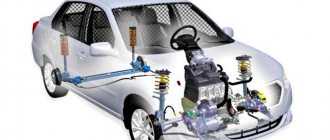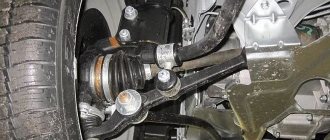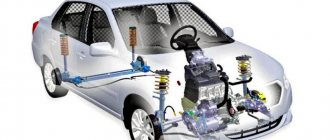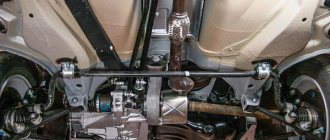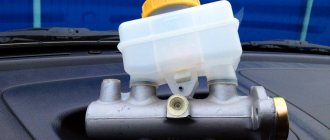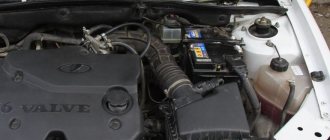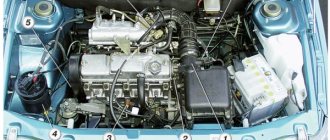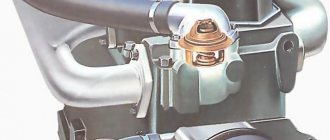When such an unpleasant situation as a coolant leak occurs, many owners of VAZ-2114 cars complain about this nuisance due to the great age of the car. However, of course, every car owner, when purchasing a car, inspected it and checked all components and parts for breakdowns, and would hardly have purchased such a car with leaks in the engine cooling system.
The video describes the process of finding the cause of an antifreeze leak on a VAZ car:
Simplified operation of the VAZ 2114 cooling system
Cooling diagram for VAZ 2114: 1 – element in the form of a plug for the expansion tank;
2 – expansion tank; 3 – hose for draining liquid from the pipe; 4 – hose passing between the radiator and the expansion tank; 5 – hose leading from the radiator; 6 – tank to the left of the radiator; 7 – aluminum tube; 8 – plug systems; 9 – tank to the right of the radiator; 10 – drain plug; 11 – middle of the radiator; 12 – casing for electric fan; 13 – plastic wings of the electric fan; 14 – electric motor; 15 – toothed pump pulley; 16 – pump impeller; 17 – camshaft drive belt; 18 – engine block; 19 – pump pipe; 20 – radiator hose with supply function; 21 – heater radiator hose with drain function; 22 – hose supplying coolant to the throttle pipe; 23 – exhaust pipe; 24 – hose for refilling; 25 – heater radiator hose with supply function; 26 – thermostat; 27 – coolant temperature sensor; 28 – coolant level indicator sensor. The coolant enters the water jacket of the engine block through the pipes. In the water jacket, the coolant circulates in a small circle until the engine (and therefore the coolant) reaches a temperature of 95 degrees Celsius.
At this moment, the thermostat opens and coolant is delivered through the pipes to the radiator. The radiator removes excess heat from the coolant. Excess hot coolant returns to the expansion tank.
The entire cooling system is under high pressure of 1.2-1.8 atmospheres, due to the operation of the pump and the increase in coolant volume due to heating.
From the above text we conclude: malfunctions of the cooling system are not easy to detect with small leaks, since the coolant evaporates almost immediately, having a high temperature, and work to find the location of the leak sometimes requires the intervention of a professional.
Attention!!!
All work on the cooling system must be carried out with the car turned off and the coolant cooled down.
Step 1. The pipe burst
Since the pipes are the “blood vessels” of the car, failure of any of them will result in loss of coolant.
This malfunction is clearly visible on a warm engine while driving. A large amount of steam appears from under the hood. The burst pipe is clearly visible.
But there are times when the coolant leak is small. Then, first of all, attention should be paid to the articulation of the pipes with the vehicle components.
When using coolant in the form of antifreeze or antifreeze, a characteristic oily coating remains in the leak areas.
Step 2. Radiator problem
A radiator malfunction is extremely difficult to detect. At the site of a coolant leak, a large amount of scale sometimes forms, making it difficult to see the location of the damage.
Pay attention to the tightness of the filler plug. If everything is OK with the tightness, then to check you will need a compressor with a pressure gauge or a pump.
Disconnect the upper pipe and connect the compressor. The pipe must be plugged. We create excess pressure and see where the leak appears. We dismantle the radiator. We take it to a specialized service center, where they will check it again under pressure, find a leak (there may be more than one) and weld it with a special compound.
Step 3. Gases in the expansion tank
This malfunction occurs due to the entry of exhaust gases (a specific smell is clearly felt in the car interior) into the cooling system under enormous pressure of 90-96 kPa.
The reason is a faulty gasket between the valve head and the cylinder block. It is caused by coolant leaking from under the expansion tank cap.
The check is quite simple. We start the engine on a cold car, remove the cap from the expansion tank and sharply press the accelerator (in common parlance, the gas pedal).
If the coolant rises sharply, the gasket must be replaced. Stop operating the vehicle immediately until the problem is resolved.
Sometimes the expansion tank cap, due to spring wear, may not withstand coolant pressure.
We recommend reading: Antifreeze in oil
Step 4. Gray emulsion instead of oil
If you notice that your car has started to “trouble”, a large amount of steam comes out of the exhaust pipe, which smells like coolant. The amount of coolant is constantly decreasing and when checking the oil dipstick, it is clear that the oil has turned into a gray emulsion.
All this indicates a malfunction of the cooling jacket of the engine cylinder block. I categorically do not recommend operating the car in this condition! In addition to the problem with the cooling system, the lubrication of all moving parts of the engine is impaired, which can easily lead to its breakdown.
Step 5. Antifreeze in the cabin
In addition to cooling the engine, the coolant is used to heat the vehicle interior. If the interior radiator or the pipes leading to it malfunction, a large amount of coolant leaks onto the floor.
The malfunction is very unpleasant, as it entails disassembling almost the entire front part of the car's interior.
What are the dangers of squeezing antifreeze out of the expansion tank?
The consequences of knocking antifreeze out of the system can be very different: it all depends on at what stage the problem was discovered. If the antifreeze has already dropped below the minimum mark, then the cooling system will not be able to protect the engine from overheating.
The reason for this is the fact that burning fuel releases a huge amount of heat, which starts the vehicle engine. But only a small part of the engine requires heating. And if the motor housing is also exposed to high temperatures, then the entire engine may begin to work incorrectly. In addition, in modern cars the structures are made in such a way that the gaps and parts are located very closely to each other. For this reason, engine overheating will also lead to breakdowns of overhead cams, aluminum parts, and so on.
As mentioned above, antifreeze can be thrown out not only outside, but also inside, getting into the engine. This causes the engine oil to mix with antifreeze and lose its properties. This way the crankshaft can be locked.
In any case, it is recommended to carry out regular inspections of the vehicle in order to detect coolant leaks. The sooner the leak is detected, the less consequences the breakdown will have.
Fix it yourself or go to a service station?
Once again I want to draw your attention, this is very important! All work on replacing cooling system elements is carried out exclusively with the engine turned off and the coolant cooled down.
You can replace the pipes, thermostat, radiator filler cap, and expansion tank cap yourself. Remove the filler cap on the radiator. Unscrew the drain plug on the engine and drain the coolant into a clean container.
As for replacing the gasket between the valve head and the piston block, repairing a rotten engine cooling jacket and repairing radiators, these works are best done at specialized stations.
Since such repairs will require the use of specific tools and the necessary experience and knowledge.
Where does antifreeze go from the radiator?
According to the laws of physics, not a single substance can disappear without a trace, the same applies to coolant (antifreeze or antifreeze). Where the liquid can go (there are three options):
- leak out through a torn pipe, a loose connection or a thin radiator;
- turn into steam due to high temperature;
- enter the engine through a leaking head gasket.
In any case, traces of coolant will be noticeable, even if the antifreeze has evaporated through the radiator cap. When the fluid leaves the OS little by little, it is not difficult to top it up, but you still need to figure out the reason for the disappearance of antifreeze. It may happen that at some point the leak will noticeably intensify, very little antifreeze will remain in the OS, and then overheating is almost inevitable.
Several important nuances when choosing cooling system components
The most important thing is to use special antifreeze or antifreeze liquids, which have a higher boiling point.
Choose pipes from well-known manufacturers, do not skimp on this. Especially when making replacements inside the car.
Replace the expansion tank cap only with the original one. Do not reduce the number of coils of the spring, they are designed for a certain pressure. It is important!
When replacing the radiator and thermostat, pay special attention to the volume and response temperature. This is critical for proper engine operation. Excessive or too low temperatures will lead to either overheating of the engine, or it will not heat up to operating temperature at all.
Hidden problems
You have looked at everything and everyone, there are no leaks anywhere, all the hoses and clamps are in order, but the antifreeze or antifreeze goes away, “even if you crack”! The fact is that there are not only open leaks, but also so-called hidden ones, and they are much more dangerous.
A car engine is not a cast structure - there is a separate engine block and cylinder head. There is a gasket between these two parts, this is mandatory, it is high-temperature (can maintain high positive values), and it is also a sealing link. In the engine block, as well as in the cylinder head, there are channels through which antifreeze (antifreeze) passes, cooling the metal, thus the “entire engine” is at an operating temperature that does not exceed 90 - 100 degrees Celsius, without this fluid the engine would very quickly warmed up and it simply jammed.
How to find out the exact cause of the breakdown?
To determine why the VAZ 2114 engine is tripping, you need to:
If you have an ODBII scanner, first of all you should carry out a comprehensive diagnosis using it. In our case, we will use a Korean-made scanner Scan Tool Pro Black Edition
.
This device was developed for the CIS market and is compatible with most domestic cars, as well as foreign cars produced in 1993. Connects via wi-fi or bluetooth and displays information on any device in Russian.
If the problem is in the cylinders, Scan Tool Pro
will show one/several errors: P0300, P0301-P0304 (PO301 code corresponds to a malfunction in the 1st cylinder, PO302 in the 2nd, etc., respectively). Also, using this device, you can track the operation of all available sensors in real time, the actual mileage of the car, its VIN and much more.
If you don’t have a scanner, use the following method:
- Detect a dead cylinder:
- start the engine and gain access to it by lifting the hood;
- remember the sound of a running engine;
- remove the wires from each cylinder one by one;
- If the sound of the working cylinder changes when you remove the wire, it means it is working. In the event of a malfunction, the character and rhythm of the sound does not change even after the power is turned off.
- Find out if a spark is getting to the cylinder:
- remove the spark plug using a special key;
- clean it from carbon deposits and soot. Sometimes simple cleaning helps, but this is only a temporary measure;
- check the integrity of the electrode. High voltage wires can be checked using a conventional multimeter;
- check for spark supply to the spark plug. To do this, you need an assistant to start the starter. The spark plug with the high-voltage wire must be attached with the metal part to the engine. If a spark does not appear when the starter bendix rotates, then the spark plug is faulty.
Poor quality fuel - sand or rust in gasoline can cause contamination of the injectors. Engines with injection type are very demanding on the quality of gasoline. Therefore, if there are problems with the engine, it is recommended to drain the fuel and use another one.
The engine stalls when cold
There are situations when the engine only stalls at idle speed. If a VAZ 2114 stalls when cold, most often the reason is a large gap between the valve and its rocker (“rocker arm”). After the engine warms up, the distance decreases and the cylinder operation stabilizes.
Other reasons are also possible:
- A “rich” or “enriched” fuel mixture is supplied due to a malfunction of the control unit.
- There is moisture on the wires or ignition coil.
- The spark plug does not work until the engine warms up.
- The piston group is worn out.
- The valve is deformed due to water hammer.
Troubling when the engine is warm
If problems with operation are observed only when the engine is warm, then the probable causes are:
- Damage to the engine control unit.
- The ignition coil sparks (pierces).
- The cylinder head gasket is worn.
Engine control unit for VAZ 2114
Coolant replacement
First of all, you need to drain the old antifreeze through the drain hole in the radiator. In this case, it is necessary to protect the generator from liquid ingress. You can speed up the draining process by removing the lid from the tank.
Draining coolant VAZ 2114
Next you need:
- Remove the heating pipe for the throttle body.
- Fill the liquid slightly above the level indicated on the reservoir.
- Press the nozzle to pump out the air.
Thus, detecting a leak in a VAZ-2114 is quite simple. You just need to carefully inspect the cooling system. And fixing a leak will not be a problem for an experienced car owner.
Connecting pipes and clamps.
To connect all elements of the cooling system, rubber or silicone pipes are used, which are secured with metal clamps. Insufficient tightening of clamps, cracking and wear of pipes lead to antifreeze leaks. Some tips on how to avoid this:
- When performing routine vehicle maintenance, inspect the cooling system pipes for leaks, cracks and swelling;
- use hoses from trusted manufacturers (of rubber hoses, Balakovo hoses (BRT) are known, opinions vary on silicone hoses, but the main thing is not to take China);
- It is recommended to use clamps from NORMA. They provide reliable fixation, do not cut the hoses with their edges, and can also be tightened not only with a screwdriver, but also with a wrench, which is convenient for final crimping. Also, some car owners successfully use self-tightening (spring) clamps from foreign cars, selecting a set according to the diameters of the pipes.
- measure the force so as not to break off the fitting of the expansion tank or radiator, especially thin ones - steam exhaust ones;
- After replacing the pipes, you need to warm up the car, and then carefully tighten the clamps again to ensure a tight seal.
The cooling system of domestic cars requires constant monitoring and regular maintenance. If a minor malfunction of the cooling system is not corrected in time, it can ultimately lead to expensive engine repairs, so do not be lazy to periodically look under the hood.
Source
Difficulties in diagnosis
Despite the fact that all such reasons are obvious, it is not always possible to independently determine where the antifreeze goes from the expansion tank. For example, very often damage to pipes remains invisible to the naked eye. In such cases, experienced car enthusiasts advise letting the engine cool completely, dry your hands thoroughly and carefully feel each connecting element. Microcracks will definitely make themselves felt , and coolant leaks will form on the hose.
How can you tell if the engine is leaking?
Signs that the VAZ 2114 engine is malfunctioning:
- jerks when driving or accelerating a car - the car does not develop the necessary power;
- increase in fuel consumption - due to malfunction of the injection system;
- uneven exhaust - you can hear popping noises and smell unburnt gasoline;
- vibrating, uneven sound of the engine - due to malfunction of the valves and all rotating parts of the engine;
- feeling of vibration and “shaking” at idle.
The origin of the phrase dates back to the days of four-cylinder engines. If one of the cylinders failed, three remained operational. Now the engine design has changed, but the common expression remains.
How to fix the problem?
After the reasons why the VAZ 2114 engine is tripping have been determined , it is necessary to act depending on the situation:
- If there are problems in the ignition system, replace the broken spark plug or high-voltage wires.
- If the reason is in the fuel injection system or compression level, clean the injectors with ultrasound, adjust or replace the valves, air filter, check the position of the timing belt.
If these actions do not lead to results, you need to check and, if necessary, replace:
- Control block;
- crankshaft position sensor;
- oxygen sensor.
Thus, engine tripping is a common breakdown that, with experience and skillful hands, can be corrected on your own. If the cause of the tripping is a breakdown in key systems (control units) or there is no special equipment at home (for example, for cleaning injectors with ultrasound), it is recommended to contact a service station.
